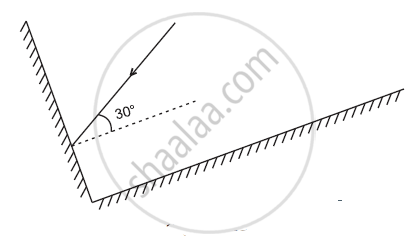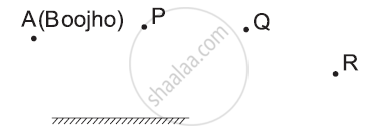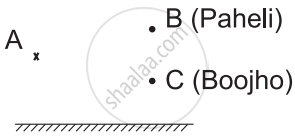Advertisements
Online Mock Tests
Chapters
2: Microorganisms : Friend and Foe
3: Coal and Petroleum
4: Combustion and Flame
5: Conservation of Plants and Animals
6: Reproduction in Animals
7: Reaching the Age of Adolescence
8: Force and Pressure
9: Friction
10: Sound
11: Chemical Effects of Electric Current
12: Some Natural Phenomena
▶ 13: Light
![NCERT solutions for Science [English] Class 8 chapter 13 - Light NCERT solutions for Science [English] Class 8 chapter 13 - Light - Shaalaa.com](/images/science-english-class-8_6:a1e5555c9030490085f2eedec974d08f.jpg)
Advertisements
Solutions for Chapter 13: Light
Below listed, you can find solutions for Chapter 13 of CBSE NCERT for Science [English] Class 8.
NCERT solutions for Science [English] Class 8 13 Light Exercises [Pages 178 - 179]
Suppose you are in a dark room. Can you see objects in the room? Can you see objects outside the room? Explain.
Differentiate between regular and diffused reflection.
Does diffused reflection mean the failure of the laws of reflection?
Mention against the following whether regular or diffused reflection will take place when a beam of light strikes. Justify your answer in this case.
Polished wooden table
Mention against the following whether regular or diffused reflection will take place when a beam of light strikes. Justify your answer in this case.
Chalk powder
Mention against the following whether regular or diffused reflection will take place when a beam of light strikes. Justify your answer in this case.
Cardboard surface
Mention against the following whether regular or diffused reflection will take place when a beam of light strikes. Justify your answer in this case.
Marble floor with water spread over it
Mention against the following whether regular or diffused reflection will take place when a beam of light strikes. Justify your answer in this case.
Mirror
Mention against the following whether regular or diffused reflection will take place when a beam of light strikes. Justify your answer in this case.
Piece of paper
State the laws of reflection.
Describe an activity to show that the incident ray, the reflected ray and the normal at the point of incidence lie in the same plane.
Fill in the blanks in the following.
A person 1 m in front of a plane mirror seems to be ______ m away from his image.
If you touch your ______ ear with your right hand in front of a plane mirror, it will be seen in the mirror that your right ear is touched with your ______.
The size of the pupil becomes ______ when you see in dim light.
Night birds have ______ cones than rods in their eyes.
Angle of incidence is equal to the angle of reflection.
Always
Sometimes
Under special conditions
Never
Image formed by a plane mirror is ______.
virtual, behind the mirror and enlarged.
virtual, behind the mirror and of the same size as the object.
real at the surface of the mirror and enlarged.
real, behind the mirror and of the same size as the object.
Describe the construction of a kaleidoscope.
Draw a labelled sketch of the human eye.
Gurmit wanted to perform Activity 13.8 using a laser torch. Her teacher advised her not to do so. Can you explain the basis of the teacher’s advice?
Explain how you can take care of your eyes.
What is the angle of incidence of a ray if the reflected ray is at an angle of 90° to the incident ray?
How many images of a candle will be formed if it is placed between two parallel plane mirrors separated by 40 cm?
Two mirrors meet at right angles. A ray of light is incident on one at an angle of 30° as shown in Figure. Draw the reflected ray from the second mirror.

Boojho stands at A just on the side of a plane mirror as shown in figure. Can he see himself in the mirror? Also can he see the image of objects situated at P, Q and R?

- Find out the position of the image of an object situated at A in the plane mirror.
- Can Paheli at B see this image?
- Can Boojho at C see this image?
- When Paheli moves from B to C, where does the image of A move?

Solutions for 13: Light
![NCERT solutions for Science [English] Class 8 chapter 13 - Light NCERT solutions for Science [English] Class 8 chapter 13 - Light - Shaalaa.com](/images/science-english-class-8_6:a1e5555c9030490085f2eedec974d08f.jpg)
NCERT solutions for Science [English] Class 8 chapter 13 - Light
Shaalaa.com has the CBSE Mathematics Science [English] Class 8 CBSE solutions in a manner that help students grasp basic concepts better and faster. The detailed, step-by-step solutions will help you understand the concepts better and clarify any confusion. NCERT solutions for Mathematics Science [English] Class 8 CBSE 13 (Light) include all questions with answers and detailed explanations. This will clear students' doubts about questions and improve their application skills while preparing for board exams.
Further, we at Shaalaa.com provide such solutions so students can prepare for written exams. NCERT textbook solutions can be a core help for self-study and provide excellent self-help guidance for students.
Concepts covered in Science [English] Class 8 chapter 13 Light are Reflection of Light, Law of Reflection of Light, Light, Terms Used in Reflection of Light, Types of Reflection, Multiple Reflections, Prism, Dispersion of Light Through Prism and Formation of Spectrum, Human Eye, Care of the Eyes, Visual Impairment and Braille System, Reflection of Light, Law of Reflection of Light, Light, Terms Used in Reflection of Light, Types of Reflection, Multiple Reflections, Prism, Dispersion of Light Through Prism and Formation of Spectrum, Human Eye, Care of the Eyes, Visual Impairment and Braille System.
Using NCERT Science [English] Class 8 solutions Light exercise by students is an easy way to prepare for the exams, as they involve solutions arranged chapter-wise and also page-wise. The questions involved in NCERT Solutions are essential questions that can be asked in the final exam. Maximum CBSE Science [English] Class 8 students prefer NCERT Textbook Solutions to score more in exams.
Get the free view of Chapter 13, Light Science [English] Class 8 additional questions for Mathematics Science [English] Class 8 CBSE, and you can use Shaalaa.com to keep it handy for your exam preparation.
